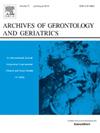急诊科的 FI 实验室与急诊住院老年人的不良后果。
IF 3.5
3区 医学
Q2 GERIATRICS & GERONTOLOGY
引用次数: 0
摘要
背景:急诊科正在收治越来越多的年老体弱患者,这与较差的治疗效果有关。急诊科通常根据分诊评分和预警评分等指标来强调决策的紧迫性。然而,对于体弱的老年人来说,这种方法可能还不够。虚弱指数实验室(FI-lab)已被用作虚弱的简单评估工具,但它也可能反映疾病的严重程度,并预测急诊环境中的不良后果。因此,我们旨在通过与使用分诊和预警评分进行的评估进行比较,评估急诊室中的 FI-lab 与住院期间不良后果之间的关联:这是一项在一家三级医院进行的回顾性队列研究。研究对象包括在急诊科接受初步评估后入住普通内科病房的 65 岁或以上患者。FI-lab 是通过血液化验中的 24 项化验参数计算得出的。国家预警评分(NEWS)、日本分诊和急性量表(JTAS)以及改良的 JTAS 也被用作预后指标,并将它们与不良预后的关系与 FI-lab 的关系进行了比较:共分析了 872 名患者(平均年龄 80.9 岁;男性占 52.6%)。住院期间死亡的患者的 FI-lab 值高于存活的患者。在多元回归分析中,FI-lab、NEWS 和改良 JTAS 与院内死亡和住院时间延长显著相关。相比之下,这些指数都与院内跌倒无关。FI-lab与出院回家的可能性独立相关:在急诊科评估的 FI-lab 反映了急性住院老年人的病情严重程度,与 NEWS 和 JTAS 相似,是预测不良后果的有用指标。这些结果可能表明了FI-lab对急诊环境中老年人的价值。本文章由计算机程序翻译,如有差异,请以英文原文为准。
FI-lab in the emergency department and adverse outcomes among acutely hospitalized older adults
Background
The emergency department is treating a growing number of older patients with frailty, which has been linked to poorer outcomes. Urgency is generally emphasized in the emergency department based on indicators such as triage scores and early warning scores for decision-making. However, this approach may not be sufficient for frail older people. The Frailty Index-laboratory (FI-lab) has been used as a simple assessment tool for frailty, but it may also reflect disease severity and predict adverse outcomes in the emergency care setting. Therefore, we aimed to evaluate the association between FI-lab in the emergency room and adverse outcomes during hospitalization through comparison with assessments using triage and early warning scores.
Methods
This was a retrospective cohort study conducted in a tertiary hospital. The study included patients aged 65 years or older who were admitted to the general internal medicine ward after being initially evaluated in the emergency department. FI-lab was calculated using 24 laboratory parameters from blood tests. The National Early Warning Score (NEWS), the Japan Triage and Acuity Scale (JTAS), and the modified JTAS were also used as prognostic indicators, and their association with adverse outcomes was compared with that of FI-lab.
Results
In total, 872 patients (mean age, 80.9 years; male, 52.6 %) were analyzed. Patients who died during hospitalization had a higher FI-lab than those who survived. In multiple regression analysis, FI-lab, NEWS, and the modified JTAS were significantly associated with in-hospital death and prolonged length of hospital stay. In contrast, none of these indices were associated with in-hospital falls. The FI-lab was independently associated with the likelihood of discharge to home.
Conclusions
FI-lab evaluated in the emergency department reflected the severity of illness in acutely hospitalized older adults, similarly to NEWS and JTAS, and was a useful indicator for predicting adverse outcomes. These results may indicate the value of FI-lab for older adults in the acute care setting.
求助全文
通过发布文献求助,成功后即可免费获取论文全文。
去求助
来源期刊
CiteScore
7.30
自引率
5.00%
发文量
198
审稿时长
16 days
期刊介绍:
Archives of Gerontology and Geriatrics provides a medium for the publication of papers from the fields of experimental gerontology and clinical and social geriatrics. The principal aim of the journal is to facilitate the exchange of information between specialists in these three fields of gerontological research. Experimental papers dealing with the basic mechanisms of aging at molecular, cellular, tissue or organ levels will be published.
Clinical papers will be accepted if they provide sufficiently new information or are of fundamental importance for the knowledge of human aging. Purely descriptive clinical papers will be accepted only if the results permit further interpretation. Papers dealing with anti-aging pharmacological preparations in humans are welcome. Papers on the social aspects of geriatrics will be accepted if they are of general interest regarding the epidemiology of aging and the efficiency and working methods of the social organizations for the health care of the elderly.

 求助内容:
求助内容: 应助结果提醒方式:
应助结果提醒方式:


